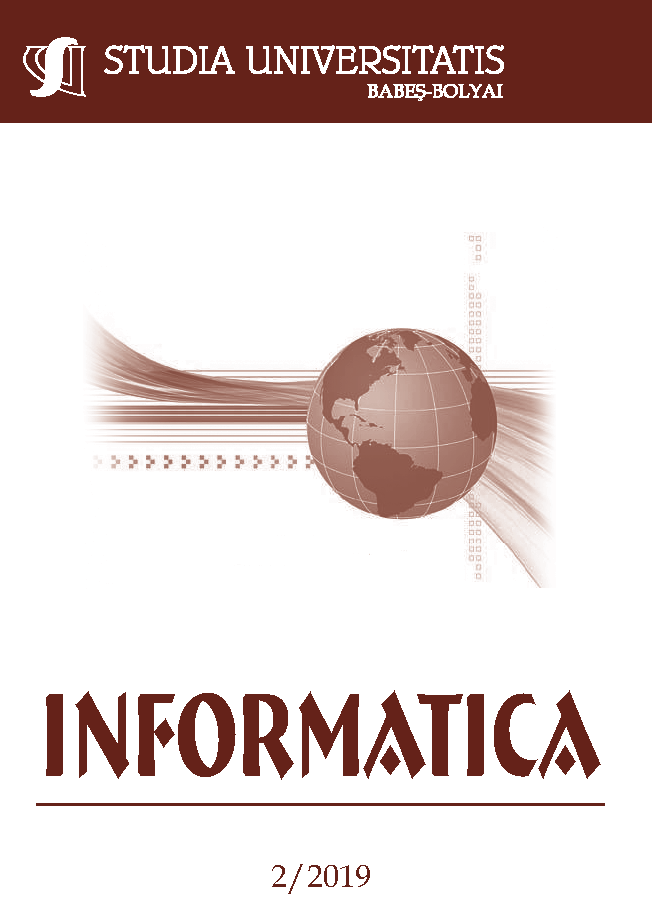ANALYSING THE ACADEMIC PERFORMANCE OF STUDENTS USING UNSUPERVISED DATA MINING
DOI:
https://doi.org/10.24193/subbi.2019.2.03Keywords:
Educational data mining, Unsupervised learning, Self-organizing map, Relational association rule.Abstract
Educational Data Mining is an attractive interdisciplinary domain in which the main goal is to apply data mining techniques in educational environments in order to offer better insights into the educational related tasks. This paper analyses the relevance of two unsupervised learning models, self-organizing maps and relational association rule mining in the context of students’ performance prediction. The experimental results obtained by applying the aforementioned unsupervised learning models on a real data set collected from Babe¸s-Bolyai University emphasize their effectiveness in mining relevant relationships and rules from educational data which may be useful for predicting the academic performance of students.
References
Academic data set, 2018. http://www.cs.ubbcluj.ro/∼liana.crivei/AcademicDataSets/ThirdDataSet.txt.
Elizabeth Ayers, Rebecca Nugent, and Nema Dean. A comparison of student skill knowledge estimates. In Educational Data Mining - EDM 2009, Cordoba, Spain, July 1-3, 2009. Proceedings of the 2nd International Conference on Educational Data Mining., pages 1–10, 2009.
Alejandro Bogar´ın, Rebeca Cerezo, and Cristóbal Romero. A survey on educational process mining. Wiley Interdisc. Rew.: Data Mining and Knowledge Discovery, 8(1), 2018.
Alina Cˆampan, Gabriela Șerban, and Andrian Marcus. Relational association rules and error detection. Studia Universitatis Babes-Bolyai Informatica, LI(1):31–36, 2006.
Gabriela Czibula, Maria-Iuliana Bocicor, and Istvan Gergely Czibula. Promoter sequences prediction using relational association rule mining. Evolutionary Bioinformatics, 8:181–196, 04 2012.
Ashish Dutt, Saeed Aghabozrgi, Maizatul Akmal Binti Ismail, and Hamidreza Mahroeian. Clustering algorithms applied in educational data mining. Intern. J. of Information and Electronics Engineering, 5(2):112–116, May 2015.
N. Elfelly, J.-Y. Dieulot, and P. Borne. A neural approach of multimodel representation of complex processes. International Journal of Computers, Communications & Control, III(2):149–160, 2008.
Syed Tanveer Jishan, Raisul Islam Rashu, Naheena Haque, and Rashedur M. Rahman. Improving accuracy of students’ final grade prediction model using optimal equal width binning and synthetic minority over-sampling technique. Decision Analytics, 2(1):1, Mar 2015.
S. Kaski, and T. Kohonen. Exploratory data analysis by the self-organizing map: Structures of welfare and poverty in the world. Neural Networks in Financial Engineering. Proceedings of the Third International Conference on Neural Networks in the Capital Markets, pages 498–507, World Scientific, 1996.
S.A. Khadir, K.M. Amanullah, and P.G. Shankar. Student’s academic performance analysis using SOM. International Journal for Scientific Research and Development, 3(02):1037–1039, 2015.
Wattanapong Kurdthongmee. Utilization of a self organizing map as a tool to study and predict the success of engineering students at Walailak University. Walailak Journal of Science and Technology, 5(1):111–123, 2008.
J. Lampinen and E. Oja. Clustering properties of hierarchical self-organizing maps. Journal of Mathematical Imaging and Vision, 2(3):261–272, 1992.
Siti Khadijah Mohamad and Zaidatun Tasir. Educational data mining: A review. Procedia - Social and Behavioral Sciences, 97:320–324, 2013.
Suhem Parack, Zain Zahid, and Fatima Merchant. Application of data mining in educational databases for predicting academic trends and patterns. 22012 IEEE International Conference on Technology Enhanced Education (ICTEE), pages: 1–4, 2012.
K. Saxena, S. Jaloree, R.S. Thakur, and S. Kamley. Self organizing map (SOM) based modelling technique for student academic performance prediction. Intern. Journal on Future Revolution in Computer Science and Communication Engineering, 3(9): 115–120, 2017.
Gabriela Șerban, Alina Cˆampan, and Istvan Gergely Czibula. A programming interface for finding relational association rules. International Journal of Computers, Communications & Control, I(S.):439–444, June 2006.
Panu Somervuo and Teuvo Kohonen. Self-organizing maps and learning vector quantization for feature sequences. Neural Processing Letters, 10: 151–159, 1999.
Yi Sun. On quantization error of self-organizing map network. Neurocomputing, 34(1-4): 169–193, 2000.
Downloads
Published
How to Cite
Issue
Section
License
Copyright (c) 2019 Studia Universitatis Babeș-Bolyai Informatica

This work is licensed under a Creative Commons Attribution-NonCommercial-NoDerivatives 4.0 International License.





